This Sichuan roasted whole chicken recipe yields an extremely juicy and tender bird with a rich flavor and crispy skin. The chicken is rubbed with Sichuan peppercorn salt, stuffed with fresh aromatics, and oven roasted to perfection. Make this the centerpiece for your next holiday gathering or dinner party and impress everyone!
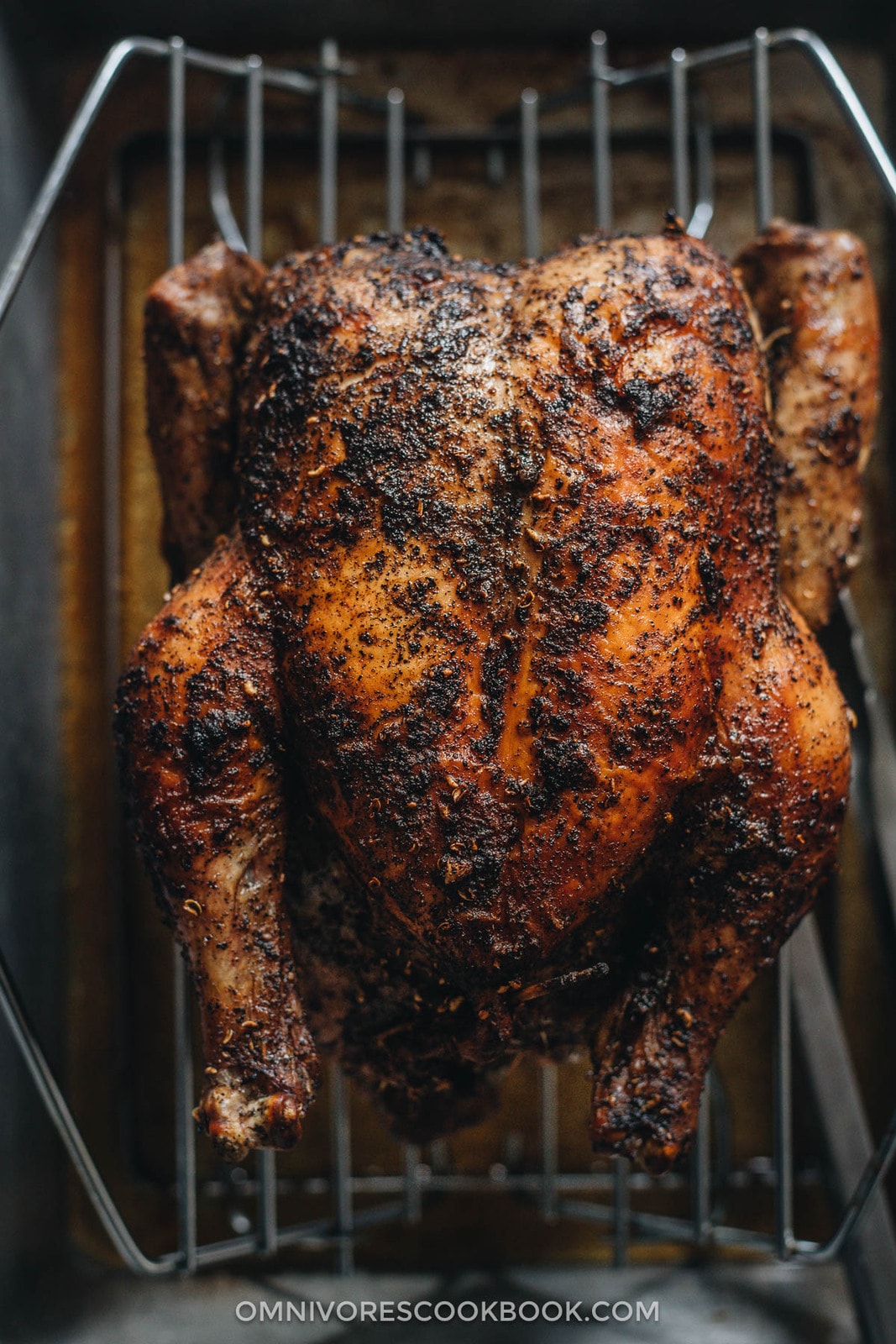
Roasting a whole chicken is always a great way to create a stunning centerpiece for your dinner. With a little advance preparation, you will have a delicious meal that makes everyone happy. It’s a good main dish for Christmas as well, in case you don’t want to roast a whole duck or goose this year.
I love roasted chicken in all forms. Although a classic roast chicken with salt and butter is just delicious enough, I do like to do something new, once in a while. That’s why I developed this Sichuan roasted whole chicken recipe. It uses Sichuan peppercorns and black tea to create a dry rub, plus plenty of fresh aromatics to stuff the chicken. The end result is a super juicy, moist, tender chicken with a rich, savory, fragrant taste.
At the end of the recipe, I’ve also included a quick chicken rice using the pan drippings from the roasted chicken. Serve it with the carved chicken for a Hainan chicken rice style dish, only 10 times more flavorful.

Cooking process & notes
1. Sichuan peppercorn salt
This recipe uses Sichuan peppercorn, black tea, garlic powder and salt to create a super rich and fragrant dry rub.
If you’ve never used Sichuan peppercorns, you’ve been missing out. A main ingredient in Sichuan cuisine, Sichuan peppercorn has a citrusy taste with a numbing tingling sensation when you chew on it. It’s a secret to add aroma to your dish that no ingredient can replace. You can purchase Sichuan peppercorns at Asian grocery stores, but I highly recommend these premium fresh ones from The Mala Market.
Inspired by the traditional tea-smoked duck, the black tea is used as a hidden spice. Just like using ground coffee on barbecued beef brisket, black tea adds another layer of umami to your chicken.
To make the spice blend, toast all the ingredients in a small pan to release the aroma and then blend them into a fine powder.
I highly recommend using a coffee grinder, which produces a very fine grind. A small food processor works too, although it might leave bigger chunks of spices in the mix.
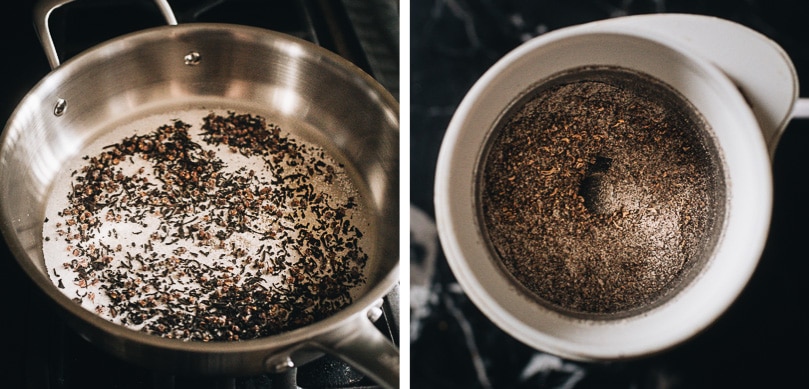
2. Coat the chicken
It might look like a lot of spices and salt. But it’s necessary to rub extra spice blend onto the outside and inside of the chicken, to yield a very rich result.
To coat the chicken, you first apply a mixture of Shaoxing wine and sesame oil, then the Sichuan peppercorn salt. Not only does it season the chicken well, but the salt will also serve as a dry brine, to keep the chicken extra moist once it’s baked.

3. Stuffing
Stuffing a whole chicken with fresh aromatics is another way to keep the meat juicy and fragrant. I used plenty of green onion and ginger to stuff the cavity, then a whole head of garlic at the end.
I also used a toothpick to seal the cavity to prevent the stuffing from falling out. Feel free to skip this if you don’t have toothpicks on hand.
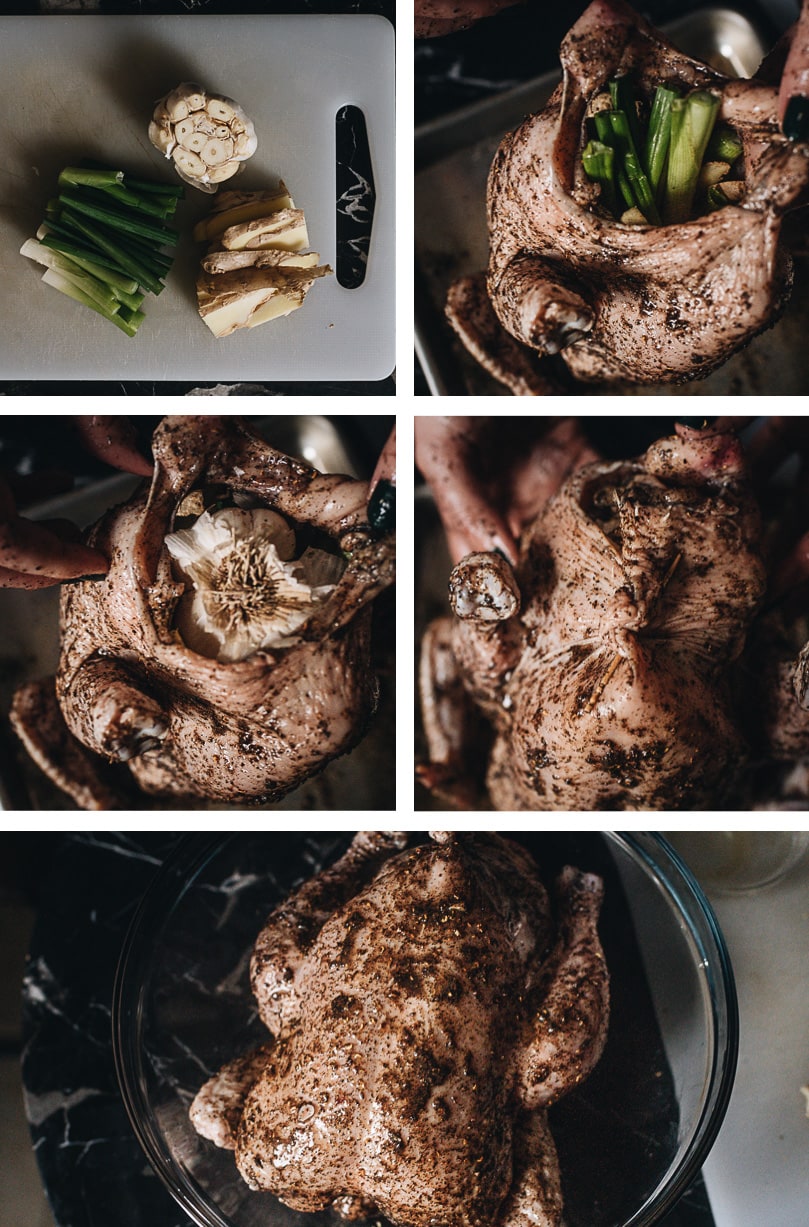
4. Marinating
Once you coat the chicken with spices and stuff it with aromatics, it’s very important to let the chicken marinate overnight. Yes, it does require a bit of patience. But the marinating is a key process to season the chicken meat and create a juicier result.
I recommend you place the chicken in a big bowl, then seal the bowl with plastic wrap. Try not to touch the chicken directly with the plastic wrap, as it will remove the spice mix once peeled off.
You should rotate the chicken once during the marinating, so it will be seasoned more evenly. But if you’re feeling lazy and do not plan to rotate it, simply place the chicken breast-side-down, so the breast meat will be seasoned properly.
5. Roasting method
This recipe uses a high temperature to brown the chicken skin and a low temperature to finish up. The opposite method works as well, but I found that using a low temperature at the end gives you more flexibility. Due to differently sized chickens and actual oven temperatures, using a low temperature at the end will ensure your chicken is cooked through and browned properly.
Once the chicken is browned, do drizzle a bit more sesame oil onto the surface before proceeding. This will prevent the spice mix from burning.
To keep the process fuss-free, you can roast the chicken without flipping it at all. But if you’re a perfectionist, there is another method I recommend.
6. How to get evenly browned thighs
I’m a dark meat fan. For me, a roasted whole chicken is all about the crispy skin. The no-flipping method works just OK, but it bothers me when the base of the chicken thigh is not browned properly.
If you like your chicken thighs browned evenly, you gotta flip the bird! I highly recommend you get an adjustable roasting rack. I shaped the rack at a 60-degree angle, so it would hold the chicken when I placed it on its side, leaving the wing and the whole thigh facing upward (pic 1).
I roast the first side at high temperature for 15 minutes. You can see in picture 2, the thigh is browning nicely after the first 15 minutes.
Then I rotate it to bake the other thigh (pic 3), only 10 minutes this time, to get the other thigh browned.
During the roasting, I also drizzle a bit of leftover marinating liquid over the chicken (pic 4).
Once you’re done roasting both thighs, turn it to a lower temperature and flip the chicken so it’s breast-up. Drizzle a bit of sesame oil onto the breast to prevent it from burning (pic 5). Keep roasting at the low temp until the chicken is cooked through (pic 6).
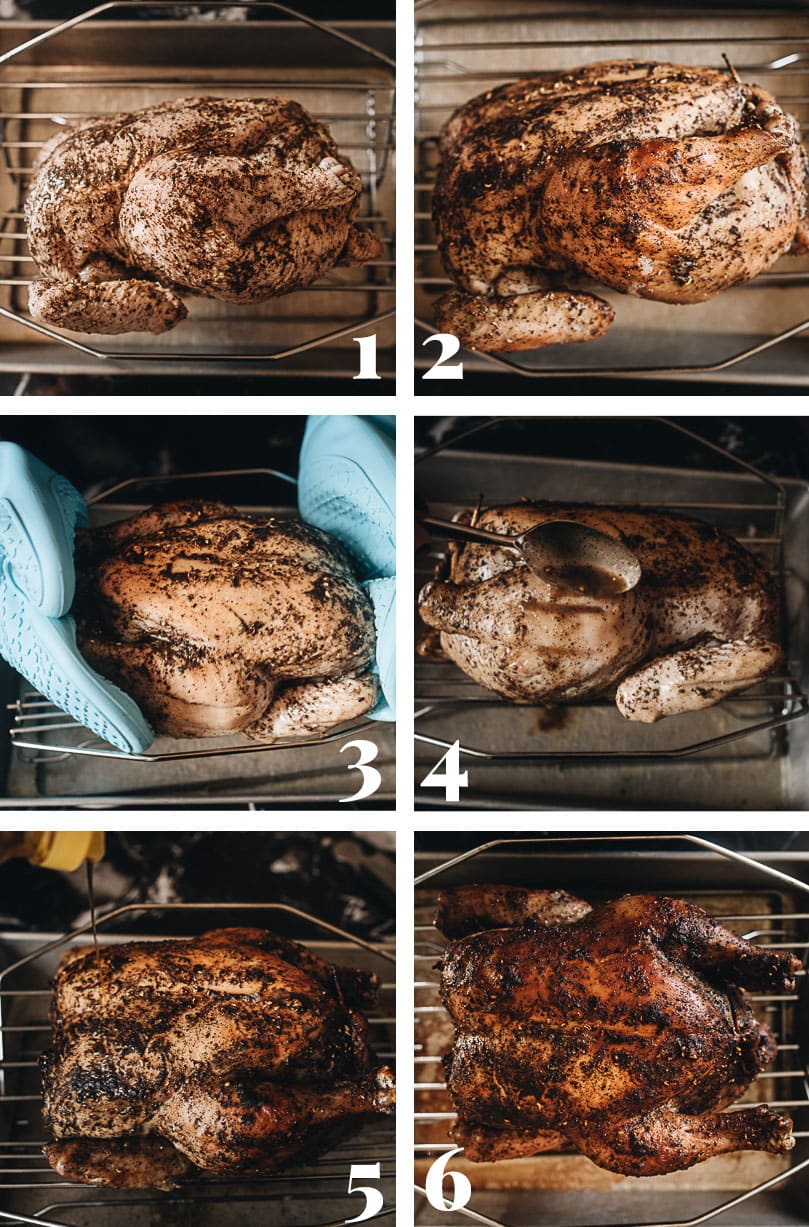
Once it’s done cooking, you can see that not only is the chicken breast brown, but the base of the thigh will be crisped up as well.
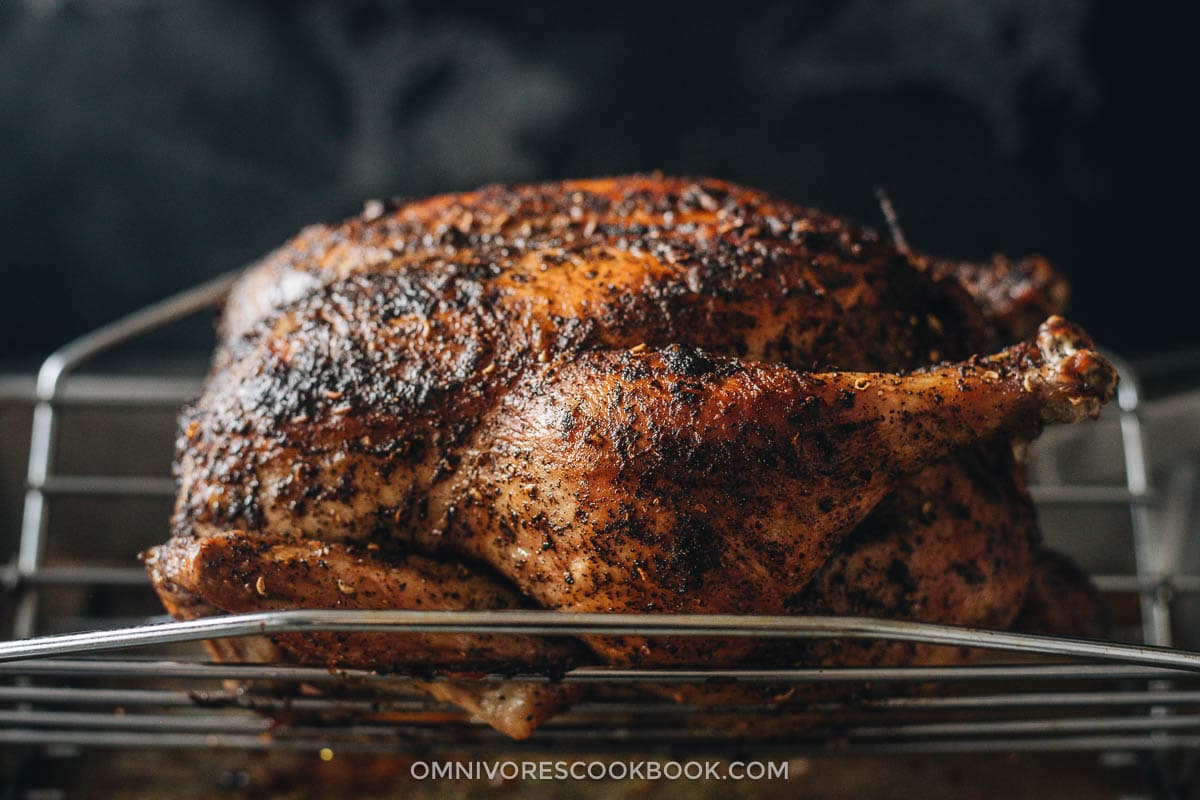
7. Bonus recipe – chicken rice
While roasting the chicken, do remember to add a thin layer of water into the roasting pan to catch the drippings and prevent them from burning. You can collect the drippings at the end of roasting and use them to make steamed rice.
You can simply use the drippings, water, and some ginger to steam rice (on the stovetop or in the rice cooker). It creates super delicious rice just like the one in Hainan chicken rice, but even more flavorful.
8. May I roast the chicken on a bed of vegetables?
Yes you totally can roast the chicken on a bed of potatoes (or any other combination of veggies). But I do find that it yields a slightly better result if you roast the chicken on a rack. The chicken will sink into the veggies and some of the thigh meat will get soggy. I also think the pan drippings create a really special rice dish that goes perfectly with the chicken. However, do feel free to use a bed of veggies if that makes your life easier.
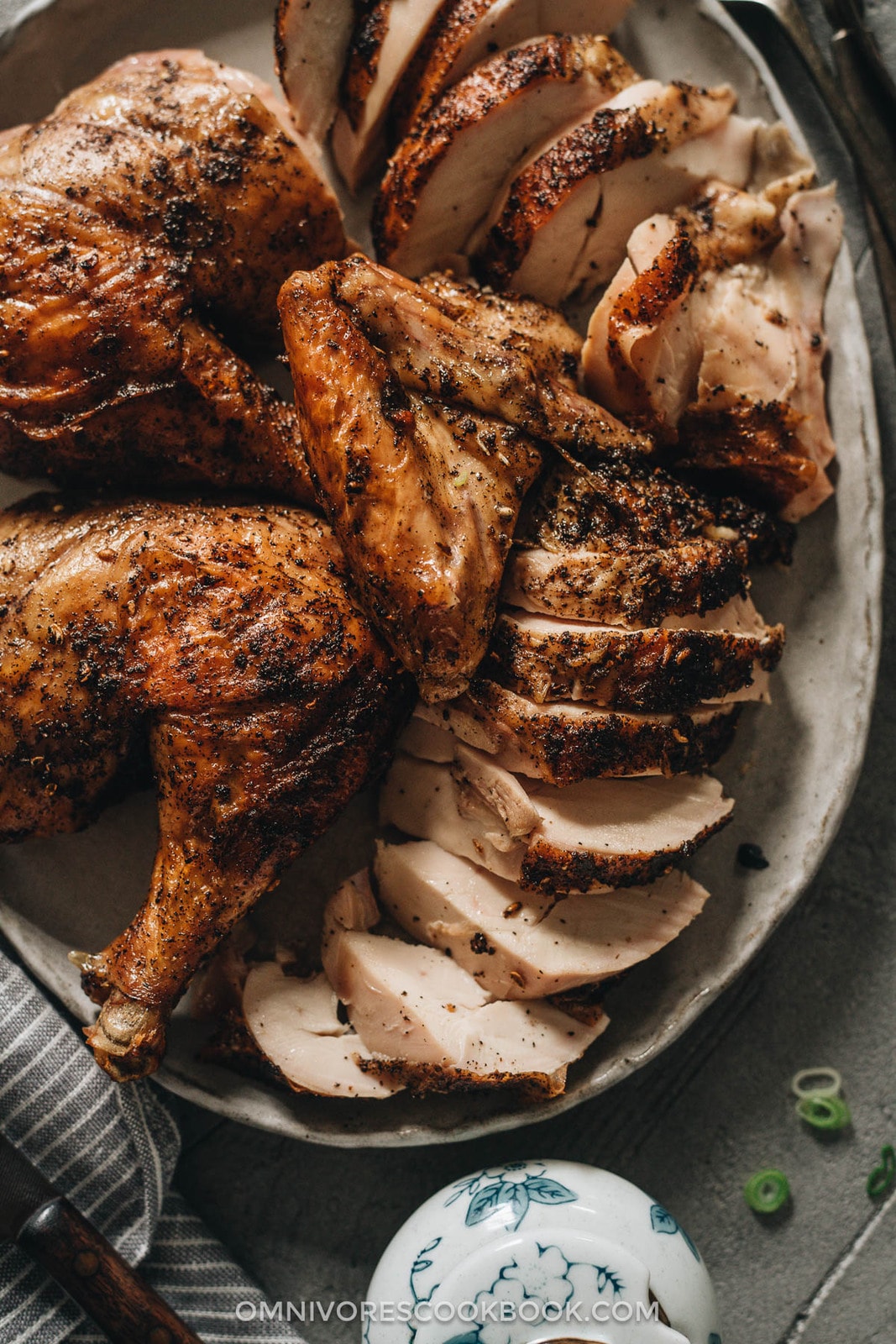
Afterthoughts
This is not the easiest roasted whole chicken recipe, but I guarantee you it is worth the effort. I’m a dark meat lover and chicken breast usually doesn’t appeal to me so much. But the finished chicken is so juicy and rich that I enjoyed the chicken breast just as well.
Side dishes to serve with this
The Sichuan roasted whole chicken is so rich that you just need something simple and fast to accompany it. Here are some side dishes I recommend:
- The Best Chinese Coleslaw
- Stir-Fried Pea Shoots with Garlic
- An Easy Chinese Broccoli Recipe
- Three-Ingredient Quick Pickled Watermelon Radish
- 3-Ingredient Garlic Broccoli Stir Fry
- Chinese 4-Ingredient Fried Cabbage
More delicious chicken recipes
- Chinese Bang Bang Chicken
- Korean Fire Chicken (Cheese Buldak)
- Salt and Pepper Chicken Without Deep-Frying
- Chicken and Broccoli (Chinese Takeout Style)
- Real-Deal Soy Sauce Chicken (See Yao Gai)
- The Best Cantonese Roast Chicken
If you give this recipe a try, let us know! Leave a comment, rate it (once you’ve tried it), and take a picture and tag it @omnivorescookbook on Instagram! I’d love to see what you come up with.
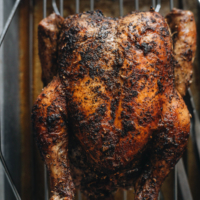
Sichuan Roasted Whole Chicken
Ingredients
- 1 (3.5 to 5 lbs / 1.5 to 2 kg) whole chicken
Sichuan peppercorn salt
- 1 1/2 tablespoon salt
- 1 tablespoon black tea
- 2 teaspoons Sichuan peppercorns
- 1 teaspoon granulated garlic (or garlic powder)
Wet rub
- 2 tablespoons Shaoxing wine (or dry sherry)
- 1 tablespoon sesame oil more to drizzle
Stuffing
- 4 green onions , sliced into 2” (5 cm) pieces
- 15 slices ginger , 2 in
- 1 head garlic , top removed
Optional - chicken rice
- 1 cup (250 ml) ice
- 2 pieces ginger , sliced
- Pan drippings + water needed for adequate rice cooking liquid
- 1 green onion , thinly sliced
- Pinch of salt
Instructions
Marinate the chicken
- Add the salt, tea, and peppercorns to a pan. Heat over medium-low heat, stirring regularly, until smoking.
- Remove the pan from the heat and add the granulated garlic. Transfer everything into a spice grinder or a small food processor. Grind until everything turns into a granulated spice mix.
- Combine the shaoxing wine and sesame oil in a small bowl. Stir well.
- Transfer the chicken into a large bowl. Rub the chicken with the sesame oil mixture on the inside and outside until well coated.
- Sprinkle the Sichuan peppercorn salt mixture onto the inside and outside of the chicken. Gently pat and rub with your hands until evenly coated.
- Stuff the cavity with green onions and ginger. Seal with the garlic, with the cut side facing the inside of the chicken. Secure the stuffing by stitching together the cavity with a toothpick (skip this if you don’t have a toothpick). Tuck the wing tips underneath the breasts to prevent burning.
- Place the chicken breast-side-down in the same large bowl. Cover with plastic wrap. Let it marinate overnight in the fridge. Rotate once halfway through marinating (it’s OK if you forget the rotating).
Roast the chicken
- Adjust the oven rack, so the chicken will be positioned in the middle of the oven. Preheat the oven to 450 °F (232 °C). Line a roasting pan with foil for easy cleaning. Pour in a cup of water to prevent the drippings from burning. Place a roasting rack into the pan.
Option 1 - Fussless roasting
- Drizzle the extra marinating liquid onto the chicken. Roast the chicken at 450 °F (232 °C) for 30 minutes.
- Take the chicken out of the oven. Turn the oven to 350 °F (176 °C). Drizzle additional sesame oil onto the chicken. Add more water to the pan if needed.
- Return the chicken back to the oven. Roast at 350 °F (176 °C) for another 30 minutes, or until the juices run clear.
Option 2 - Extra crispy thigh
- If you happen to have an adjustable roasting rack, you can use this method to get extra crispy thighs. Start the roasting by shaping the roasting rack into a “V” shape. Grease the rack with a thin layer of oil to prevent sticking. Place the chicken on its side, so the thigh and the wing are facing up. Drizzle a few teaspoons of the marinating liquid onto the chicken. Roast at 450 °F (232 °C) for 15 to 20 minutes, until the top of the thigh turns golden brown.
- Take the chicken out of the oven. Wearing a pair of oven mitts and holding both ends of the chicken, flip it so the other thigh and wing face up. Drizzle the rest of the marinating liquid onto the chicken. Continue to roast at 450 °F (232 °C) for 10 to 15 minutes, until the top of the thigh turns golden brown.
- Take the chicken out of the oven. Turn the oven to 350 °F (176 °C). Drizzle additional sesame oil onto the chicken. Add more water to the pan if needed.
- Return the chicken to the oven. Roast at 350 °F (176 °C) for another 30 minutes, or until the juices run clear.
Test doneness and rest
- For a smaller chicken (under 4 lbs / 1.8 kg), I would test the chicken at the 20-minute mark, just in case, to avoid overcooking. For a bigger chicken, you might need 10 minutes or more of additional roasting time at 350 °F (176 °C) to finish.
- For a more accurate reading, use an instant-read thermometer, inserted into the thickest part of the thigh and breast. The thigh should read at least 160 °F (71 °C) and the breast at least 155 °F (68 °C). While resting, the temperature of the dark meat will continue to go up and should reach 165 °F (74 °C), the safe temperature recommended by the FDA. Note, I prefer to cook chicken breast slightly under 165 °F (74 °C), which yields super juicy and tender results.
- Let the chicken rest for at least 10 minutes before serving. It will stay pretty hot for about 30 minutes.
(Optional) Bonus - chicken rice
- Collect the pan drippings in a measuring cup. Add water to the drippings to reach the needed amount of liquid, depending on the type of rice you’ll make. You will need 1 3/4 cup of liquid for jasmine rice, or 1 1/4 cup of rice for medium or long grain rice. Check out my rice cooking guide for more information.
- Add the rice into a small saucepan. Add water to cover. Rinse in a circular motion with your fingers a few times. Drain the water and repeat the process one more time. Drain the water thoroughly.
- Add the pan dripping water mixture, ginger, and a pinch of salt.
- Cook over medium heat until the water comes to a full boil. Cover the pan and turn to low heat immediately. Steam 15 minutes for jasmine and long grain rice, and 18 minutes for medium grain rice. Do not uncover the pot during steaming.
- Once the rice is done cooking, remove the pan from the stove. Let sit, covered, for another 10 minutes.
- After resting the rice, use a fork or spatula to fluff it. Taste the rice. Add more salt and mix again, if needed.
Serving
- Once rested, carve the chicken and top it onto the rice. Garnish with green onion. Serve hot as a main dish.
Notes
- The nutrition facts are calculated based on 1 serving of roasted chicken without the rice.
Nutrition
Lilja Walter is a part of the Omnivore’s Cookbook team and worked closely with Maggie to develop and test this recipe.
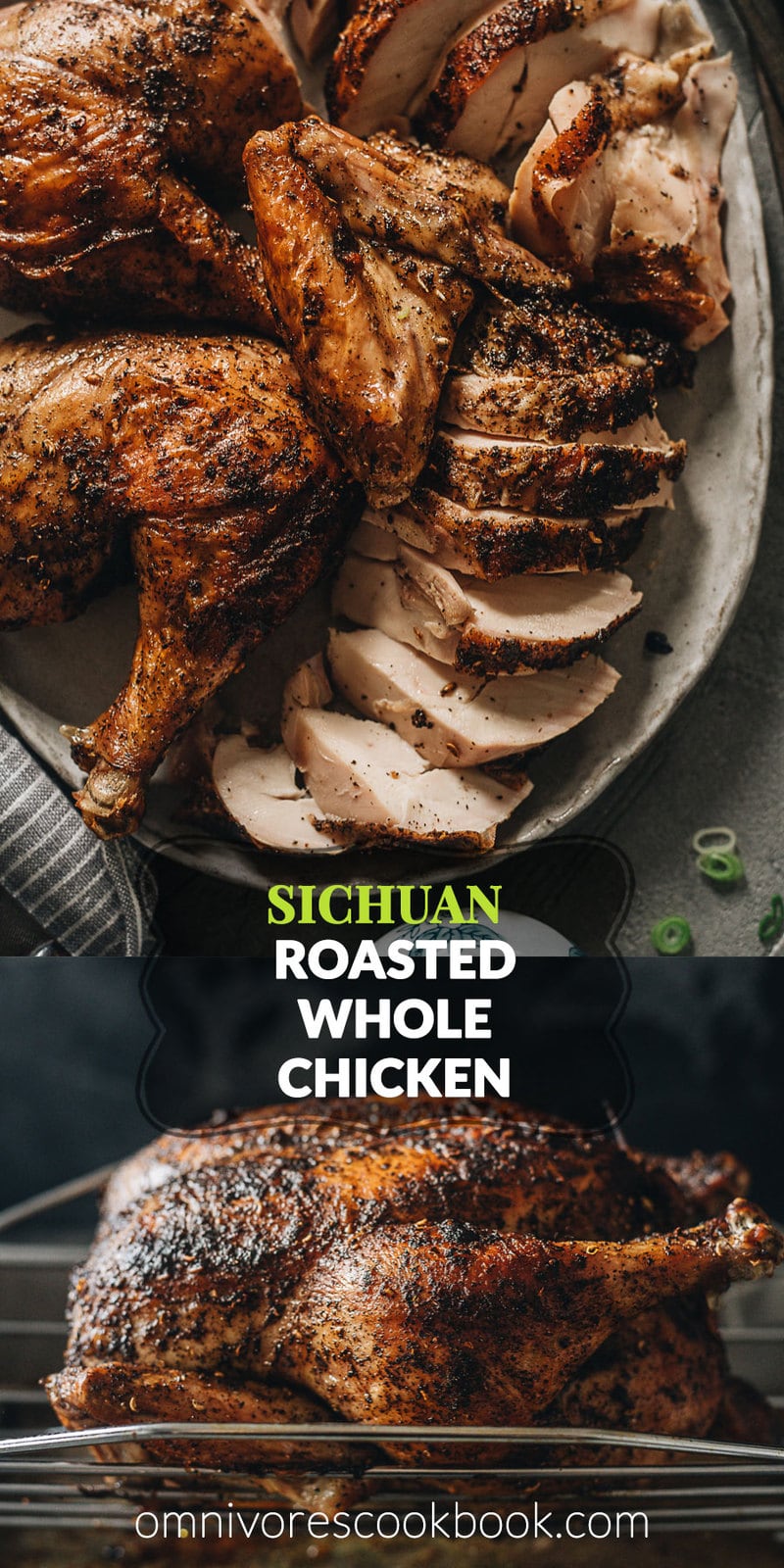













This is basically the same ingredients as a Chinese smoked chicken, which I make often. It is just simpler since you don’t have to dedicate a pot for smoking (one never really gets all the smoke off afterwards). The smoked version uses just a rub of crushed Sichuan peppercorns and salt, toasted in a dry pan, rubbed over the bird (smallish chicken about 2 1/2 lbs) inside and out and left to marinate overnight in the fridge, then the chicken is boiled for 10 minutes in water with soy sauce, scallions and ginger, then heat turned off and chicken left in pot till water cools to room temp, which finishes the cooking. Then it is drained and smoked by strewing black tea leaves, sugar and flour – dry on the bottom of pot (line the pot with aluminium foil for easier cleanup), add chicken raised off the bottom so it doesn’t touch the smoking ingredients, pot is sealed with close fitting lid, put over medium heat which creates an aromatic smoke, and smoke for about 8 minutes then turn chicken to other side and smoke for about 5 minutes. Remove bird and brush with sesame oil. Done.
I made this for Christmas dinner with a chicken +shiitake zong zi recipe I have, your smashed cucumbers + garlic and garlic+ chili green beans and it was perfect!!! The chicken was so tender and the flavor just absolutely wonderful. I had never cooked a chicken high heat then low heat and I think that combined with the overnight marinade…perfection. I was also really surprised how much the spice blend smelled like black sesame (one of my favorite flavors!) – I’m very much looking forward to leftovers for lunch tomorrow. This will be a go-to recipe for sure, thank you so much!
Wow that’s a very fancy Christmas dinner spread! So happy to hear you tried this dish for your gathering and liked the recipe 🙂
Merry Christmas and happy holidays!
I followed your instruction to the letter, and what a dish.!!! Is absolute joy. You are amazing thanks so much
My husband, who is from Hong Kong, and generally only tolerates chicken dishes said this was the best chicken he has ever had at home or at a restaurant. It definitely takes prep time but it was super delicious. Thank you.
I think you mean one cup of rice, not ice 😁
Loved this! We love crispy skin so I used our vertical roaster which means I skipped the stuffing, but it was still flavorful and the skin was wonderfully crisp.
This looks delicious and I wan to try out. Before I start I am confused about the “marinating liquid” that is referenced in this recipe. What exactly is used for the marinade?
Sorry about the confusion! I was talking about the pan dripping – it contains the seasonings so I used “marinating liquid”.
Great collection!